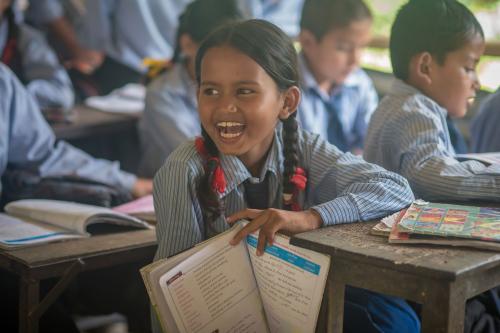In President Obama’s visit to the Middle East this week, one aspect that should not be overlooked on his agenda is education in Syria. Education is often not seen as an immediate priority during a conflict, yet is as critical now to Syrian youth and children as it is for the longer-term stabilization and eventual rebuilding of their country. The state of education in Syria is not only a reflection of the current turmoil but, as we have learned from neighboring countries in-post conflict times, especially Iraq, it is also a strong indication of its future.
UNICEF’s recent report on the state of education in Syria is alarming. At least 2,400 schools have been destroyed and an additional 1,500 are being used as shelters for displaced persons. In some cities, children have already missed out on almost two years of schooling. Across the country, parents, understandably, are reluctant to send their children to school as school buildings have been targeted by armed forces. Many children fled Syria with their families disrupting their education and forcing them to adjust to new, and often time harsh, conditions. The two years of conflict in Syria has had a severe impact on its education system. If not prioritized now, the consequences could be devastating in the long-term for Syria, as has similarly occurred in Iraq.
Education in pre-war Iraq was arguably one of the best in the region with 100% gross enrollment rates, almost complete gender parity, low drop-out rates, and government spending of approximately $620 per student. Compare that with Iraq during and after the war: gross enrollment dropped, the gender gap increased significantly, the drop out reached 20% and government spending per student dropped to $47. Education continues to be the target of violence and destruction even today. UNESCO reports that going to school in Iraq remains a dangerous activity. In the span of five years (2003-2008), over 31,500 attacks on educational institutions were reported. The impact of the conflict in Iraq on its education system has been devastating and will continue to be felt for generations to come.
For Syria, as in Iraq and in most countries affected by conflict, if education is not prioritized urgently and systematically, we can also expect the same devastating legacy. It will result in less children and youth going to school, fewer years of schooling, lower literacy rates and even worse outcomes for those who were marginalized before the conflict, including girls and women. This Syrian mother’s quote in Save the Children’s recent report, Childhood Under Fire, depicts the new grim reality:
“My daughter, she is 16 and she loved school. She was the first in her class, and she wanted to become an architect. But this war…we were too worried for her. We could not protect her, so we had to marry her. I know that men are hurting women, old women, single women – everyone. We needed her to have a protector…What about marriage? ‘Your cousin is a good man, take him, he is good.’ So she said ‘As you wish’. But she did not want to get married, she wanted to study. But there were no more schools. So… she was married. This is happening a lot within Syria, many women I know are marrying their daughters – even younger than 16 – to protect them.”
If Syria’s post-conflict education system is left to follow in the same path as Iraq’s, it will not only exacerbate state fragility, but also obstruct development and hurt those who are most vulnerable. This 16-year-old Syrian girl’s story could become the story of an entire generation of young women who lose the chance to be educated, to be empowered and to have the tools they need to participate in the rebuilding of their country.
The United States government could lead the way in supporting an education relief plan and a longer-term multi-stakeholder rehabilitation plan of the sector as a whole. It should begin by funding UNICEF’s $20 million ask for education programs in Syria for which it has only received $3 million so far. Proven strategies for ensuring continuity of education amid crisis, such as setting up child friendly spaces for learning in homes and other safe spaces, are important not only for children’s learning outcomes but their psychosocial well-being. Funding shortfalls are preventing the provision of urgently needed prefabricated classrooms, repairs and rehabilitation of learning spaces, and the provision of learning materials. For Syrians who fled to neighboring countries, targeted support should be given to U.N. agencies and particularly to Jordan, where over 29,000 Syrian children have been given access to schools despite Jordan’s own schools being already overcrowded and burdened by previous flows of refugees.
To stop at the urgent needs of Syria’s education system however, would be short sighted. Supporting Syria’s education needs over the long term is a must. As President Obama and his administration consider the future of Syria, they must ensure that the legacy of Syria’s conflict is not another broken education system and its devastating consequences for Syria, the Middle East and the world.
The Brookings Institution is committed to quality, independence, and impact.
We are supported by a diverse array of funders. In line with our values and policies, each Brookings publication represents the sole views of its author(s).



Commentary
Education and President Obama’s Trip to the Middle East
March 21, 2013